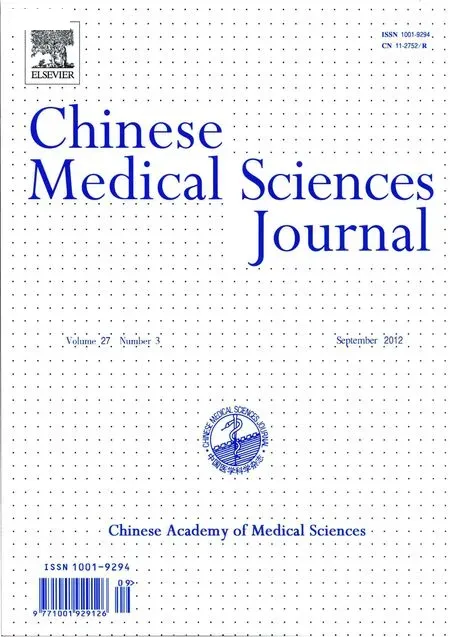Effect of Ethylenediaminetetraacetic Acid (EDTA) Gel on Removing Smear Layer of Root Canal in Vitro
Poudyal Sitashi and Wei-hong Pan*
Department of Stomatology,Union Hospital,Huazhong Science &Technology University,Wuhan 430022,China
FOR smear layer removal from root canal walls,ethylenediaminetetraacetic acid (EDTA) is an effective chelating agent and its efficiency depends upon a lot of factors such as concentration,pH,duration of application,the type of the solution,the root canal length,penetration depth of the material,and hardness of the dentin.The aim of this scanning electron microscopic study was to evaluate the effectiveness of 19%EDTA gel on smear layer removal at different time periods when used as a final step in the irrigation regime.
Forty mandibular premolars with single canals and straight mature roots extracted for orthodontic reasons without previous restorative or endodontic therapy were collected.Soft tissues,calculus or debris attached to the extracted tooth surface were removed.Using carborundum discs,deep grooves of about 0.1-0.5 cm were cut on the ducal and palatal surfaces of the roots without perforating the root canal and stored in 0.9% saline solution at 4°C.
Each tooth was mounted on plaster of paris consisting of CaSO4·2H2O in a vertical direction such that the occlusal surface was not embedded in plaster of paris and a conventional access cavity was prepared.To determine the working length,a K-type file (DENTSPLY,USA) was used.The apical foramen was penetrated with size 15 K-file and was pulled back into the clinically visible apical foramen,and the working length of each tooth was 19 to 22 mm.Each canal as instrumented with step-back technique and the apical foramen was enlarged to a size 40 file.Three milliliters of 2.5% NaOCl was used as a root canal irrigant during the preparation.
The 40 extracted teeth were randomly divided into 5 groups∶A,B,C,D,and E,with 8 teeth in each group.EDTA gel (19%,Meta Biomed Co.Ltd.,Mandaluyong,Korea) was used in all the experimental groups for different time periods of;Group B,1 minute;Group C,3 minutes;Group D,5 minutes,and Group E,7 minutes.The control Group A was not lubricated with 19% EDTA gel.All the five groups were then irrigated with distilled water.Irrigation was performed using an endodontic syringe and a 22-gauge blunt-end needle.The canals were dried with absorbent paper points.Each tooth was again mounted on plaster of paris in a horizontal direction such that one of the longitudinal grooves created was not embedded in plaster of pairs.Teeth were then split with chisel and mallet into two halves.
One half of each tooth was selected and prepared for scanning electron microscopy examination.Fixation of the specimen was done in 2.5% glutaraldehyde for 30 minutes and washed in distilled water for 30 minutes.Specimens were then progressively dehydrated by absolute alcohol;mounted on coded stubs and sputter-coated with gold.
The specimens were then analyzed by using a Philips SEM XL 30.Three areas in the middle third of the sample were selected and observed at magnifications of up to×1000 for the presence or absence of smear layer and visualization of the dentinal tubule openings.An experienced evaluator,unaware of the experiment protocol scored the images,and photomicrographs of the most representative areas were taken at ×2000 magnification.For the evaluation of smear layer,score of 1=absence of smear layer;2=less than 25% of the canal walls covered by a thin smear layer and visible dentin tubule openings;3=patchy distribution of smear layer with up to 50% of the area covered with smear layer;4=thin homogeneous smear layer covering the prepared canal wall;5=thick inhomogeneous smear layer covering the prepared canal wall.
Group A (control) and Group B specimens showed inhomogeneous smear layer attached to a large area of root canal wall covering most of the dentinal tubule openings.Group C and Group D specimens showed partially opened dentinal tubules with a thin homogenous smear layer surrounding the per tubular dentin and white precipitate of smear plugs blocking the tubular opening.Group E specimens when observed throughout the entire length of the root canal showed large number of wide open dentinal tubules with smear layer free per tubular dentin.
Statistical analysis showed that root canal wall smear layer scores of samples in Groups A (4.98±0.24),B(4.55±0.21),and C (4.01±0.19) had no statistically significant difference (allP>0.05).Group D (3.01±0.13) and Groups B (P<0.05),Group C and Group A (P<0.05),Group D and Group C (P<0.05),and Group E (1.12±0.10) and Group D (P<0.01) all showed statistically significant difference in their smear layer removal scores.
The root canal irrigation time is one of the important factors that influence the efficiency of EDTA.Based on the results,after the irrigation of 2.5% NaOCl,when 19%EDTA gel was used as a lubricant for 1 and 3 minutes,effective smear layer removal could not be obtained,whereas at 5 and 7 minutes effective smear layer removal was obtained.In contrast to this result,some scholars along with NaviTip FX were able to achieve almost smear layer and debris free root canal walls when 19% EDTA gel was used for 1 minute.This difference may be attributed to the active brushing along the length of the root canals for 1 minute with File-Ez.In a recent study,10-minute treatment with EDTA and NaOCl did not significantly alter the chemical and ultra morphologic structure in young root canal dentin whereas excessive demineralization and erosion was seen in old dentin.In the present study,though the degree of erosion was not evaluated,there was little or no dentinal erosion observed when 19% EDTA gel was used for 7 minutes.This difference may be attributed to the lot of factors like form of EDTA,its concentration,pH or protocols followed.
 Chinese Medical Sciences Journal2012年3期
Chinese Medical Sciences Journal2012年3期
- Chinese Medical Sciences Journal的其它文章
- Hypercalcemia Appeared in a Patient with Glucagonoma Treated with Octreotide Acetate Long-acting Release
- Zinc Finger Protein-activating Transcription Factor Up-regulates Vascular Endothelial Growth Factor-A Expression in Vitro△
- Comparison of Clinical Effects of Au-Pt Based and Ni-Cr Based Porcelain Crowns
- Clinical Analysis of Placenta Previa Complicated with Previous Caesarean Section△
- Hipbone Biomechanical Finite Element Analysis and Clinical Study after the Resection of Ischiopubic Tumors△
- Accuracy Validation for Medical Image Registration Algorithms:a Review△
